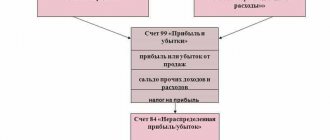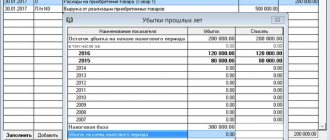In civil law, entrepreneurial activity is an activity aimed at making a profit, carried out at one’s own risk. Few organizations or individual entrepreneurs started working immediately with financial returns, but absolutely everyone takes risks.
It doesn’t matter what you do - sell goods, build houses, provide intermediary services, produce spare parts or rent out real estate, there is always a chance that, at the end of the next year, you will see a loss in your report. How critical is the negative result between income and expenses for current affairs and the future, why does it arise at all, and is it possible to get rid of it - questions that I will try to answer today.
The concept of loss in accounting
The definition can be found in paragraph 79 of the PBU, approved by Order No. 34-n dated July 29, 1998. More precisely, it provides a joint definition of profit and loss - this is the result obtained in the reporting period when accounting for all business transactions as a result of assessing balance sheet items according to the rules adopted by law.
Those. To determine the result in the BU, two conditions must be met:
- Fully reflect all transactions in accounting.
- Correctly form the lines in the balance sheet and report (former form 2).
Why am I focusing on this? If the primary data was taken into account incorrectly in the accounting department or was not indicated at all, then the totals in the accounts will be distorted, and they form the balance sheet items. In turn, incorrect distribution of some balances among lines and sections will lead to distortion of the balance sheet and financial results statement.
Based on the initial meaning, a loss is a negative result of economic activity. Roughly speaking, when expenses exceed income. The results of the year show not only the effectiveness of work over the past period, but also form a strategy for the future. If there is no profit, you will have to figure out what went wrong.
When transferring normalized expenses, it is difficult to guess the limit of the future period
Sometimes taxpayers artificially transfer to the future costs that, according to the norms of the Tax Code of the Russian Federation, must be normalized. An example would be the cost of producing prizes awarded to the winners of drawings as part of an advertising campaign. According to paragraph 4 of Article 264 of the Tax Code of the Russian Federation, such amounts are allowed to be reflected in tax accounting in an amount not exceeding one percent of revenue. If documents related to the production of prizes are temporarily “lost,” the accountant will have to forecast the revenue for the period in which they are “found.” It is possible that one percent of the proceeds will be less than the cost of the prizes, and then some of the expenses will not be taken into account.
How does a loss occur?
It arises differently in three types of accounting: accounting, tax and management (MA). What is the difference between reflecting transactions:
- The moment of reflection of operations. In accounting, as a rule, the accrual method is used, i.e. transactions are carried out at the time of their completion, regardless of the actual receipt of funds, but the cash method is rarely used. This is possible in accordance with the last paragraph of paragraph 12 of PBU 9/99 and paragraph two of paragraph 18 of PBU 10/99, if the company has the right to use simplified accounting methods.
In NU, both methods can be used depending on the taxation system. On OSNO it is traditionally the accrual method, on the simplified tax system it is always cash.
Management accounting reflects all real expenses, including those that for some reason were not included in official reports.
- Goals. Accounting is maintained for all documented transactions; its data forms reporting of interest to the Federal Tax Service, auditors, founders, shareholders, investors, i.e. external and internal users.
The tax office creates the basis for the preparation of declarations, calculations of insurance premiums, etc. It determines the amount of taxes to be accrued and paid to the budget.
Managerial is necessary for internal use, to provide an idea of the real picture of expenses and income; for external users it is useless, because cannot always be documented and justified.
- By use. Accounting data is used for inventory, reconciliation of calculations, analysis of warehouse balances, settlements with employees, participants, and other counterparties. With complete, transparent accounting, its information will form the basis for planning and strategic development of the enterprise.
NU transmits information to government bodies - the Federal Tax Service, the Pension Fund of the Russian Federation, the Social Insurance Fund, on the basis of which conclusions are drawn about the financial condition of the organization, reductions in certain types of costs or, conversely, about their increase, data from different reports are compared to identify unreliable or distorted data.
Management serves as a planning tool if accounting does not fully show real costs and resources.
Based on the foregoing, losses arise in each type of accounting in different ways. In NU it appears only in some taxation systems, when forming the tax base:
- BASIS for income tax.
- The simplified tax system is “income minus expenses” for a single tax.
- Unified Agricultural Tax under the unified agricultural tax.
In the operating system it is displayed almost similarly to accounting, maintained by the cash method. In general, the formula is simple: the balance of funds in the accounts (at the organization's cash desk) at the beginning of the period minus actual costs plus revenues. Sometimes forecast indicators are also added.
Accounting
In accounting, a loss occurs if one of the following situations occurs:
- An inventory was taken and shortages were identified, including cash. As a result, write-off occurs due to the norms of natural loss (this applies, for example, to products - fresh vegetables, fruits, etc.), and the guilty persons (storekeeper, cashier, seller).
In other cases, when it is impossible to identify the culprit or as a result of the trial a decision is made not in favor of the organization, operations are carried out with the participation of account 94 in the following way:
- D 20, 25, 23, 44... K 94 - the write-off of the shortage is reflected.
- D 90.2 K 20, 25, 23, 44... - when closing the period, costs are written off as cost.
- D 90.9 K 90.2 – a balance is formed.
- D 99 K 90.9 – the loss is written off to financial results.
Or Debit 91.2 Credit 94, Debit 91.9 Credit 91.2, Debit 99 Credit 91.9 - depending on the type of shortage.
- An increase in expenses while maintaining the same level of income. An increase in costs is associated with situations such as: installation of new fixed assets, when the equipment is launched, depreciation is included in expenses, but the products produced are not yet sold, or office space is rented for a separate division, rent is accrued, but the new office does not yet generate income. Accordingly, cost items (accounts 20, 44, 25, 26 and others) increase, but revenue (account 90.1) does not.
- The same level of expenses remains the same, but sales are falling. Sales have fallen or are nonexistent, as in 2021, due to the coronavirus pandemic, many organizations in the field of trade, catering, tourism, and transportation were forced to suspend work. The reasons may be poor marketing or personnel policies: ineffective advertising, errors in promotion, incorrect selection of personnel, outflow of highly qualified personnel, etc. The bills are the same as above, only costs do not increase, but revenue decreases.
- Accounts receivable are written off. The counterparty was liquidated, a court decision denied you the right to collect the debt, or the deadline for filing a claim has passed - in these cases, it is necessary to write off the debt in accounting. Organizations must create a reserve for this case, but it is not always enough, and then the remaining part is written off by posting D 91.2 K 62, 60, 76..., increasing costs.
- New organization. Starting a business is always associated with significant investments, and you can wait a long time for the first sales and money to appear. As a result, there are expenses, but no revenue yet. This situation is normal for a newly registered company and is not a reason for interest even from the Federal Tax Service.
- Inactive organization. There are actually a lot of them. It would seem that you are not working, which means you need to close, but sometimes the organization finds itself in a period of “downtime” for objective reasons: The owner decided to temporarily cease operations, but retain the legal entity (the life of the company is important, and the founder does not want to open a new one in the future) .
- The organization has a status that will be difficult to restore. For example, he has membership in an SRO, a valid license, a certificate of the right to carry out any work, a contract for long-term lease of state property, etc.
- The company's assets are low-profitable at the moment, but will become highly profitable in the future. Let's say that it is now impossible to sell an entire factory building, because... it is located in an inaccessible area, but within a few years a new road will be built next to it, which will improve the infrastructure and allow the building to be sold for much more.
Note! Using faster depreciation write-offs increases the risk of losses. For example, if you purchased equipment belonging to the sixth depreciation group with a useful life of 10 to 15 years and set the minimum SPI to 10 years.
Important! The accounting system must necessarily create a reserve for doubtful debts (clause 70 of the Accounting Regulations approved by Order 34-n); no exceptions are provided.
Moreover, even a non-working organization has expenses: a watchman’s salary, rent, land tax, etc. Some people maintain a bank account and pay for maintenance.
- A new company, trying to conquer its niche, lowers its price to attract a buyer.
Probably the most common question that the chief accountant hears from the owner at the end of the next year and summing up the results is “Why is there money in the account, but there is no profit and I cannot receive dividends?” The points above are often the answer.
Explanations why the company did not make a profit in this period
Let's say you decide not to hide the real state of affairs. A profit-loss declaration has been submitted to the Federal Tax Service. Inspectors will definitely check whether your company is using illegal methods to reduce taxes. Therefore, controllers often demand an explanation for the lack of profit. An inspector has the right to request clarification during a desk audit of a loss-making declaration. Inspectors were given five days to respond.
Prepare your explanations in any form. The main thing is to clearly explain the reason for the negative financial result. Tell us also about what measures are being taken to make a profit in the future.
In each case, the reasons for the loss are individual. For example, your organization is new to the market. Explain to the tax authorities that the company has just started its activities and the product is new to customers. Therefore, sales revenue is still minimal. And most of the costs are associated with advertising and marketing activities that will help develop the market. Or your company is just getting ready to start production and is spending large sums on the purchase of equipment. Support your arguments with a breakdown of income and expenses.
If the company has been in business for a long time, describe why revenue decreased or expenses increased. The decrease in revenue can be explained by a decrease in sales volumes or dumping policies. And the increase in costs is due to the development of new production facilities, repair or modernization of equipment. Write that a positive economic effect from today's spending is expected in the future.
In your explanations for inspectors, also indicate the sources of financing for the company’s activities. This could be loans, credits or financial assistance from owners. Tax authorities are always interested in how a loss-making organization lives.
Usually, inspectors are satisfied with detailed and reasoned explanations. But if a company is at a loss for more than two reporting periods in a row, there is a chance that it will receive an invitation to a commission. And when inspectors have an unspoken intention to ensure additional revenues to the budget, they can even call an organization that has received a loss for the first time or the amount of it is very small.
Before inviting a company to a commission, tax authorities will send an information letter. In it they will offer to reduce the loss and send adjustments. If the inspectors do not receive a reasoned answer, they will call the company to a commission.
Usually the manager is called to the commission, but instead an accountant or other authorized person can represent the interests of the company. The main thing is that the representative can have a constructive conversation with tax authorities and answer their questions about the company. You must take your passport and power of attorney with you. So, the commission date has been set. If the company conducts real business and you can explain the reason for the loss, there is no need to worry before the meeting. Is the excitement too great? Bring a colleague with you to help. For example, a lawyer or an accounting employee.
Try to have a constructive dialogue with the inspectors. When inspectors ask questions, take your time to answer. Better think carefully and formulate your own thoughts. After all, in a hurry or out of excitement, you can give out details that tax officials can cling to in search of violations. If, as a result of the conversation, the inspectors become interested in any documents, ask them to formalize the request in writing to the organization. Most likely, controllers will insist that you adjust your statements and show profit. But they have no right to demand this. Whether losses are reported or hidden is up to you to decide.
Loss in reporting
All year you have been conscientiously accounting for all business transactions, and the time has come to create financial statements, which come in two types: complete and simplified. The complete set consists of 6 reports and applications. This does not mean that you have to take the entire set. Those who have not experienced changes in capital or target income do not submit the corresponding applications.
Only certain categories of organizations specified in paragraph 4 of Article 6 of the Accounting Law 402-FZ are entitled to submit simplified reporting:
- SMP.
- NPO.
- Participants of the Skolkovo project.
However, organizations that are required to undergo an audit, some types of cooperatives, companies engaged in microfinance operations, public sector employees and a number of other organizations cannot use this right.
Many organizations, as small businesses, use their right. In this case, you only need to submit the first two reports: a balance sheet and a statement of financial results, as well as a report on targeted funds, if any (for non-profit organizations that cannot be classified as SMEs by definition, this is always mandatory).
Of course, you will not see the loss of the reporting period separately in the balance sheet; it records account balances at the end of the year. We are looking for all the information in the second report.
In a simplified form, there are only a few lines (their number is in brackets):
- revenue (excluding VAT and excise taxes) (2110);
- ordinary expenses (2120);
- interest payable (2330);
- other income (2340);
- other expenses (2350);
- tax (2410);
- net profit (loss) (2400).
Indicators are indicated in a generalized form; they are disclosed in more detail in the explanatory note (not always necessary). Organizations using the simplified tax system indicate a single tax in the income tax line. The total row is calculated by adding rows 2110 and 2340 and subtracting all the others from them.
The full report is somewhat broader, it reveals each indicator more fully. For example, it is not included in the cost price, but separately shows commercial and administrative expenses, reflects income from participation in other organizations, interest not only payable, but also received, and generates interim results.
The form also contains special lines: income tax and current and deferred taxes included in it. These are the formulations for those who apply PBU 18/02. Organizations on the general taxation system, if they can maintain simplified accounting, but have waived this right, or those who initially must maintain only complete ones, use the specified Regulations when calculating income tax.
The second part of the report contains lines of reference data: results from the revaluation of assets or from other transactions that were not included in the calculation, as well as profit (loss) per share (for joint-stock companies).
For comparison, the forms have two columns - according to the reporting period and the same period last year. This way you can track the dynamics of indicators.
Important! In some cases, when errors have been corrected in the financial statements, it is possible that the data indicated for the previous period in the current report will not coincide with last year’s (Part II of PBU 22/2010).
Net profit (loss) of the reporting period is located in line 2400 of the income statement form.
What does a “loss-making” declaration mean?
This means that at the end of the year, instead of profit, a tax loss was formed, as a result of which there will be no income tax indicator for payment. Tax loss is the negative difference between income and expenses that are taken into account for tax purposes.
The task of the Federal Tax Service is to ensure the modern calculation of taxes and the flow of funds into the budget. The Federal Tax Service is often overly attentive to companies operating in the red. For tax authorities, losses are a sign of a number of illegal actions of the director - tax evasion, withdrawal of assets, deliberate bankruptcy, fraud, etc.
Impact on activities
How the presence of a loss in accounting will affect the organization is the question that owners and managers primarily ask. If your management stubbornly believes that you need to pay taxes as little as possible, therefore there should be as many expenses as possible (by the way, not always real), and a loss is generally super (yes, there are many of those too), show them the following list of reasons why it’s bad such situation:
- Dividends . Despite the fact that the founder is pleased with the income in management accounting, a loss in accounting will not allow the accrual and payment of dividends. Even if there are millions in the account. Part or all of the retained earnings from previous years (if any) can be used to cover this; this allows the indicators to be leveled (although dividends still cannot be paid), but makes it impossible to distribute the available profits for other purposes.
- Loans. Would you give a loan to a person who spends more than he earns and is in the red? Hardly. The bank will have the same attitude towards the organization if you decide to take out a loan; even collateral is unlikely to help in this matter.
- Bank guarantees . Participation in public procurement under 44-FZ involves in some cases the use of bank guarantees: when submitting an application, concluding a contract, providing guarantee obligations to the customer. This allows you not to distract or freeze working capital. This is especially true for large contracts, when the security amounts are substantial, you may simply not have that kind of money, and state employees do not indulge performers with advances. The bank will again evaluate the financial position of the procurement participant, and negative indicators will not be beneficial.
- Participation in procurement. Participation in trading itself is called into question if you have unprofitable activities. According to 44-FZ, accounting reports are not required, but according to 223-FZ they are, because customers set their own requirements (federal law gives such a right) in relation to a potential participant and performer. These include the submission of reports for the previous year, confirming the reliability of the future supplier or contractor (availability of assets, absence of debts, etc.)
- Checks and requirements. The Federal Tax Service checks not only the loss in the income tax return or the simplified tax system, it will also be interested in the “accounting” negative result. Most likely, the service will inquire about the reasons, perhaps request documents. In particularly advanced cases (if you ignore the requirements), an on-site inspection is possible.
- Bankruptcy. Losses go hand in hand with bankruptcy. By themselves, of course, they do not indicate insolvency, but indirectly they do. If you are delaying payments to the supplier, he checked your statements (this can really be done, even the consents are open data) and found out that there has been a loss for a couple of years, there is a possibility that the creditor will go to court with a demand to declare the organization bankrupt. You will have to prove your worth to the judge or negotiate.
- Liquidation. Again, losses do not necessarily mean that net assets have fallen below share capital, but most likely they have. The tax service has the right to initiate a liquidation procedure by going to court (clause 11 of Article 7 of the Law “On Tax Authorities of the Russian Federation”), and the organization is obliged to make a decision if the situation does not change for three years in a row.
Options for solutions: liquidation or reduction of the capital. Moreover, if it is minimal, then, on the contrary, it may be necessary to increase it, bringing it to the level of the average.
Probably not a single item will please the owners. Cost reduction and optimization can be carried out without bringing the company to a crisis (even a formal one).
Tip 2: How to remove the lock code on your phone
Most phones use a lock code. It is designed to hide the data that the owner deems necessary. This is done in order to prevent possible losses in case of loss or theft of the phone. However, it often happens that owners themselves forget the lock code. In this case, you need to reset it along with the firmware, or reset it to standard, or disable it. Instructions 1 In order to get rid of the lock code completely and at the same time reflash the phone, you will need synchronization with a computer. Use a data cable and drivers. If this was not included in the package, buy a data cable for your phone model and download the drivers separately. Also, download the phone flashing software and the factory firmware version. Reflash the phone, after which the lock code will disappear. 2 Contact your phone manufacturer. Prepare documents confirming your ownership of the phone. Remember that the more documents you submit, the faster you will be given what you want - codes to reset settings and reset the firmware. Resetting the firmware is necessary in order to completely wipe the phone, while a factory reset will reset all settings to default. Also, request a standard lock code. 3 After you reset the settings, open the settings and apply the received standard lock code to disable it completely. If you reset the firmware, you will not need to disable the lock code in the settings. Video on the topic
- phone lock code
How to avoid losses
Are there ways to get rid of a loss in accounting? Actually yes. Let's consider the best options that are feasible in any organization:
- Distribute expenses. If you notice that you are approaching a critical level at the end of the year, try to transfer part of the costs to the next year: do not hastily write off materials just so that “remains do not dangle,” increase the useful life of the operating system by reducing the amount of depreciation, do not torment employees at the end year, reporting persons can submit reports in the next year (expenses are recognized at the reporting date).
- Reject doubts. Do not accept, remove expenses that raise doubts, leave only reliable ones. Yes, this may entail correction of declarations (but not always) - agree with the manager what is more important to him, but do not forget to formulate and voice your own opinion.
- Revision of accounting policies. Inventory and equipment worth up to 40 thousand can be recognized as fixed assets in accounting (clause 5 of PBU 6/01), this needs to be fixed in the accounting policy, then the costs of inexpensive fixed assets will be distributed more evenly.
You can write off inventories using the FIFO method (clause 16 of PBU 5/01), i.e. starting with the cost of the first batch and moving on to the last. Since prices for many goods rise regularly, this will allow, with a large turnover of materials, to reduce the costs included in the cost price.
Don’t forget about computer programs, systems, digital signatures, antiviruses; they can be reflected in accounting as deferred expenses for the duration of keys, certificates, licenses, etc., and not written off at once.
- Carry out a thorough inventory. It is not for nothing that it must be held by the end of the year. If an unaccounted object is found, other income will increase.
- Get debt forgiveness. If there is a noble person or organization that is willing to forgive the accounts payable (for example, the owner who provided the loan), then the benefit received will also increase other income.
- Do not write off accounts receivable. The situation is completely opposite - creating a burden both in tax and accounting by writing off debt that is about to become hopeless is not always useful. Sign a reconciliation report with your counterparty or file an application to court for collection and the statute of limitations will be extended.
- Accept work. There are only a few days left until the new year, the work on site has been completed, but your customer is ready to accept work only after the holidays - agree to sign the act in December and reflect the revenue in the closing year. By the way, this can also be beneficial for the customer. The manager does not always understand this, so try talking with the chief accountant or economist. Although maybe they are also trying to cut their costs.
This article is in no way a call to hide any transactions or provide false data. A competent specialist distinguishes between concealment of facts of economic activity and optimization, and the chief accountant must be able to optimize accounting without violating the law.










